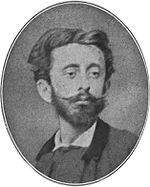You can help expand this article with text translated from the corresponding article in French. (September 2013) Click [show] for important translation instructions.
|
Tristan Corbière (18 July 1845 – 1 March 1875), born Édouard-Joachim Corbière, was a French poet born in Coat-Congar, Ploujean (now part of Morlaix) in Brittany, where he lived most of his life before dying of tuberculosis at the age of 29. He was a French poet, close to Symbolism, and a figure of the "cursed poet".[1]
Tristan Corbière | |
|---|---|
 Portrait of Tristan Corbière, ca. 1865 | |
| Born | Édouard-Joachim Corbière 18 July 1845 Morlaix, Brittany, France |
| Died | 1 March 1875 (aged 29) Morlaix, Brittany, France |
| Occupation | Poet |
| Genre | Poetry |
| Literary movement | Symbolism |
He is the author of a single collection of poetry Les Amours Jaunes, and of a few prose pieces. He led a mostly marginal and miserable life, nourished by two major failures due to his bone disease and his "ugliness" which he enjoyed accusing: the first is his sentimental life (he only loved one woman, called "Marcelle" in his work), and the second being his passion for the sea (he dreamt of becoming a sailor, like his father, Édouard Corbière). His poetry carries these two great wounds which led him to adopt a very cynical and incisive style, towards himself as much towards the life and world around him.
He died at the age of 29, possibly from tuberculosis, a childless bachelor with no work, entrenched in his old Breton manor, misunderstood by his contemporaries, and his innovative poetry was not recognised until well after his death.
Family and schooling
editHis mother Marie-Angélique-Aspasie Puyo, 19 years old at the time of his birth, belonged to one of the most prominent families of the local bourgeoisie. His father was Antoine-Édouard Corbière, known for his best-selling novel Le Négrier. A cousin, Constant Puyo, was a well-known Pictorialist photographer.
During his schooling at the Imperial Lycée of Saint-Brieuc where he studied from 1858 until 1860, he fell prey to a deep depression, and, over several freezing winters, contracted the severe rheumatism which was to disfigure him. He blamed his parents for having placed him there, far from his family's care and affection. Difficulties in adapting to the harsh discipline of the college's noble débris[2] (distinguished relics, i.e., teachers) gradually developed those characteristics of anarchic disdain and sarcasm which were to give much of his verse their distinctive voice.
Poetry
editCorbière's only published verse in his lifetime appeared in Les amours jaunes, 1873, a volume that went almost unnoticed until Paul Verlaine included him in his gallery of poètes maudits (accursed poets). Thereafter Verlaine's recommendation was enough to establish him as one of the masters acknowledged by the Symbolists, and he was subsequently rediscovered and treated as a predecessor by the surrealists.[3]
Close-packed, linked to the ocean and his Breton roots, and tinged with disdain for Romantic sentimentalism,[4] his work is also characterised by its idiomatic play and exceptional modernity. He was praised by both Ezra Pound and T. S. Eliot (whose work he had a great influence on).[5]
Eliot used his self-description as "Mélange adultère de tout" as the title for one of his own (French) poems.[6] Many subsequent modernist poets have also studied him,[7] and he has often been translated into English.[8]
His complete poems appear in two volumes with translations by the English poet Christopher Pilling.[9][10]
A very precise commented version of Les Amours jaunes was published in 1993 by Elisabeth Aragon and Claude Bonnin for the Presses universitaires de l'université de Toulouse-Le Mirail. It is now on open and free access: https://new-pum.univ-tlse2.fr/wp-content/uploads/2020/05/Les_amours_jaunes.pdf
See also
editReferences
edit- ^ Verlaine, Paul (1884). Les Poètes maudits, 1884: Tristan Corbière, Arthur Rimbaud, Stéphane Mallarmé.
- ^ Renzo Paris (ed) Corbière:Gli Amori gialli, Milan 2004 p.vii
- ^ Wallace Fowlie, Poem and Symbol (2010) p. 94
- ^ Geoffrey Brereton, A Short History of French Literature (1954) p. 299
- ^ Warner, Val (2003). Centenary Corbière. New York: Routledge. ISBN 0-415-96939-5.
- ^ Wallace Fowlie, Poem and Symbol (2010) p. 96
- ^ S. Cushman et al eds., The Princeton Encyclopedia of Poetry and Poetics (2012) p. 891
- ^ Val Warner intro, Centenary Corbière (2003)
- ^ These jaundiced loves A translation of Tristan Corbière's Les Amours Jaunes by Christopher Pilling. (Calstock Cornwall: Peterloo Poets, 1995)
- ^ Oysters, Nightingales and Cooking-Pots: Selected Poetry and Prose of Tristan Corbière, trans. by Christopher Pilling, ed. by Richard Hibbitt and Katherine Lunn-Rockliffe (York: White Rose University Press, 2018). Open access publication; free on https://universitypress.whiterose.ac.uk/site/books/10.22599/Corbiere/
External links
edit- Works by Tristan Corbière at Project Gutenberg
- Works by or about Tristan Corbière at the Internet Archive
Content in this edit is translated from the existing French Wikipedia article at fr:Tristan Corbière; see its history for attribution.